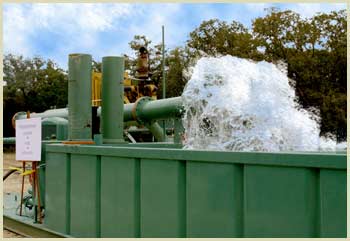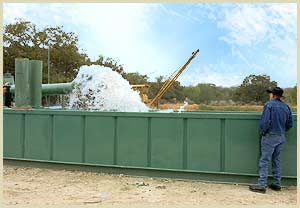


 Metropolitan
Water Company, L.P.
("Met Water") was established in 1999 for the purpose of developing
groundwater resources through out the State of Texas. W. Scott Carlson
is the President of Metropolitan Water Company of Texas, L.L.C., which
is the general partner of Met Water. Mr. Carlson's background, for over
20 years, was in the oil and gas exploration business in Southeast
Texas and along the Texas Gulf Coast. In 1999, he realized that his
skills were equally applicable to the development of groundwater in
Texas. He also surmised that the next major water resource to be
developed in the State was a groundwater resource in the central Texas
area known as the Carrizo-Wilcox
Aquifer.
Metropolitan
Water Company, L.P.
("Met Water") was established in 1999 for the purpose of developing
groundwater resources through out the State of Texas. W. Scott Carlson
is the President of Metropolitan Water Company of Texas, L.L.C., which
is the general partner of Met Water. Mr. Carlson's background, for over
20 years, was in the oil and gas exploration business in Southeast
Texas and along the Texas Gulf Coast. In 1999, he realized that his
skills were equally applicable to the development of groundwater in
Texas. He also surmised that the next major water resource to be
developed in the State was a groundwater resource in the central Texas
area known as the Carrizo-Wilcox
Aquifer.
Texas Water Law Background
 Historically, Texas water law
has distinguished between two types of water - surface water and
groundwater. Surface water, the water in rivers, streams and lakes, is
owned by the State of Texas and may be used by persons only after
obtaining a permit from the State. On the other hand, groundwater, the
water percolating in aquifers
beneath the surface of the State, has been held to be essentially
private property, and the right to use the water is a part of the
surface owner’s rights. Generally, the surface owner has been entitled
to use any groundwater he can obtain by drilling a well on his
property. This law, known as the rule of capture, is much like oil and
gas law at its inception. Slowly, however, particularly over the last
fifty years, Texas has begun to create local districts to regulate the
amount of groundwater a landowner may capture, thus encroaching on the
rule of capture in certain local districts where groundwater supplies
have been diminishing or are threatened.
Historically, Texas water law
has distinguished between two types of water - surface water and
groundwater. Surface water, the water in rivers, streams and lakes, is
owned by the State of Texas and may be used by persons only after
obtaining a permit from the State. On the other hand, groundwater, the
water percolating in aquifers
beneath the surface of the State, has been held to be essentially
private property, and the right to use the water is a part of the
surface owner’s rights. Generally, the surface owner has been entitled
to use any groundwater he can obtain by drilling a well on his
property. This law, known as the rule of capture, is much like oil and
gas law at its inception. Slowly, however, particularly over the last
fifty years, Texas has begun to create local districts to regulate the
amount of groundwater a landowner may capture, thus encroaching on the
rule of capture in certain local districts where groundwater supplies
have been diminishing or are threatened.Water Resource Market
